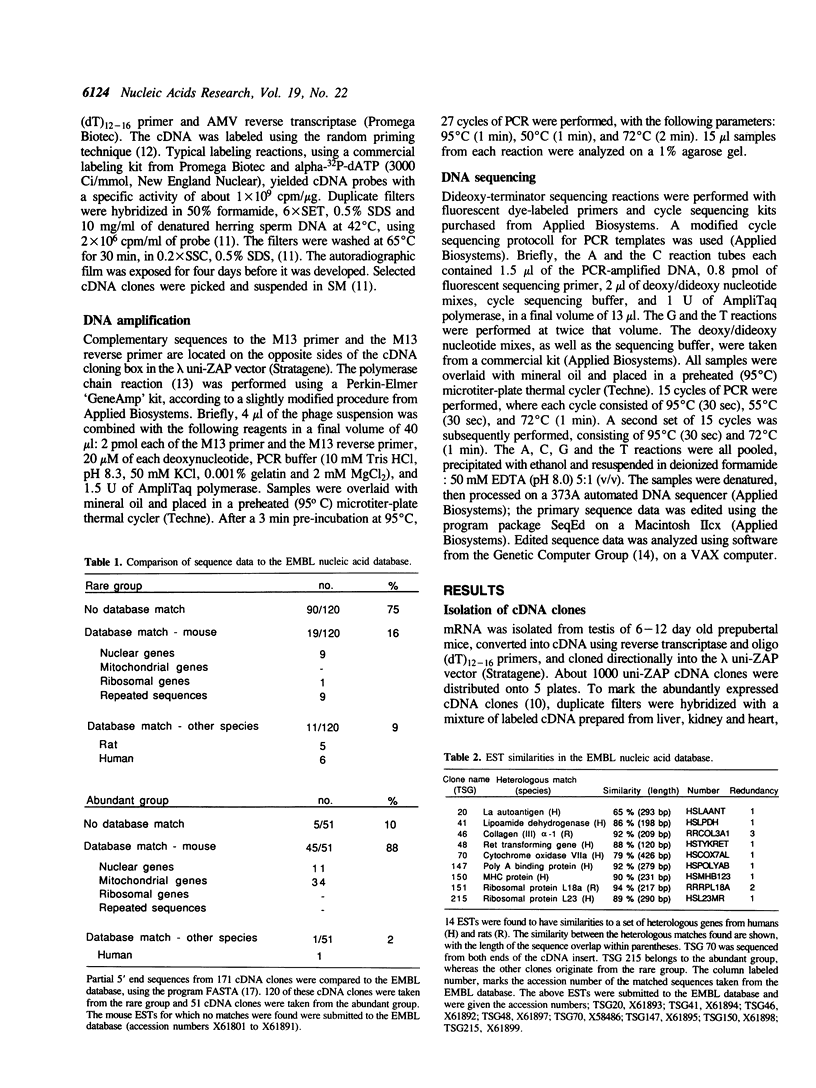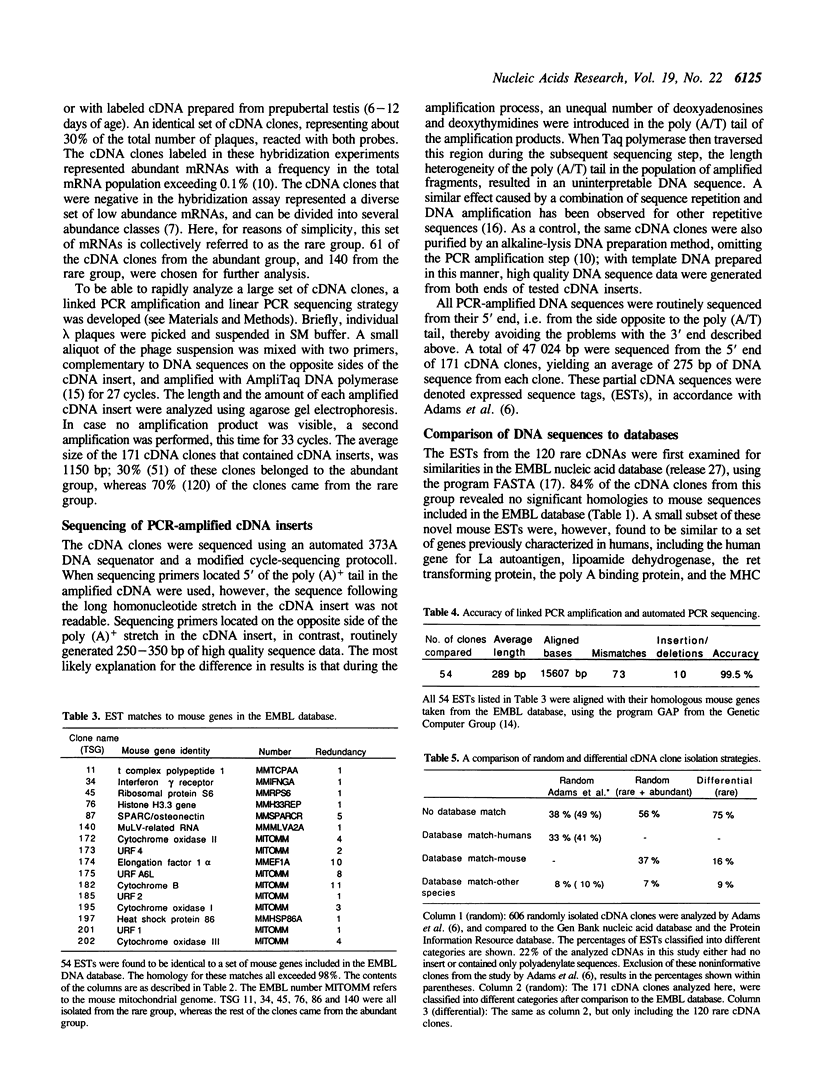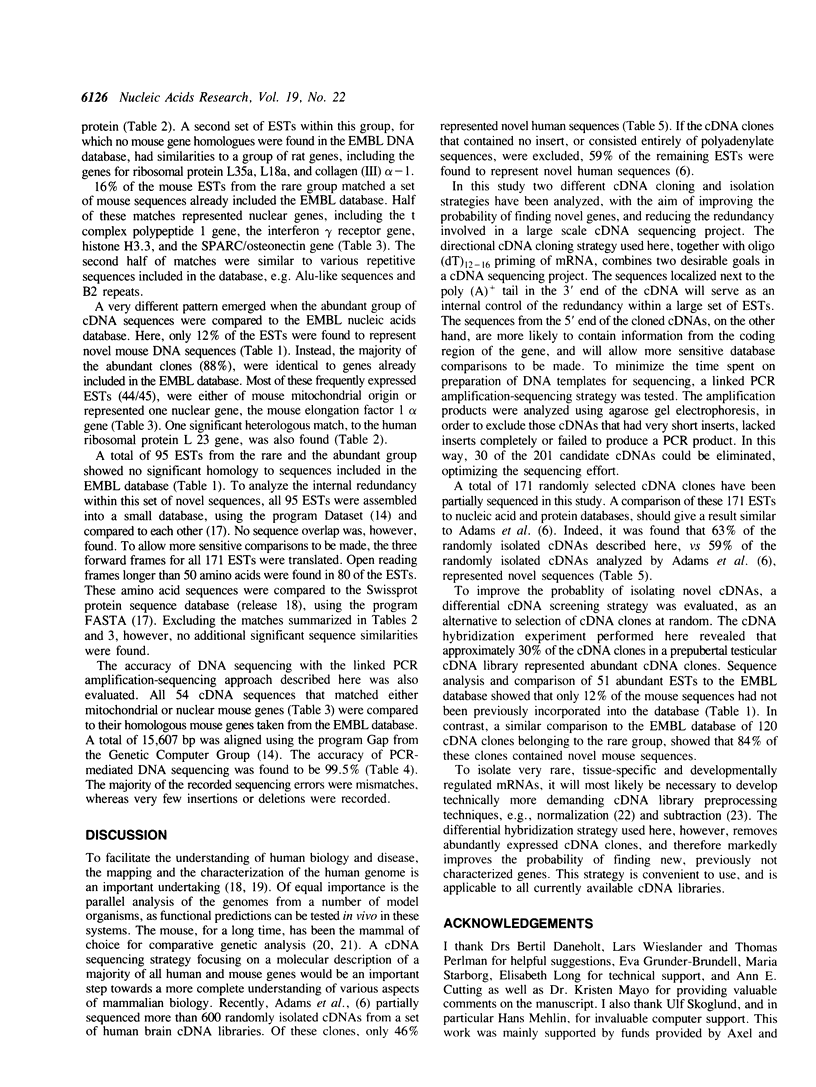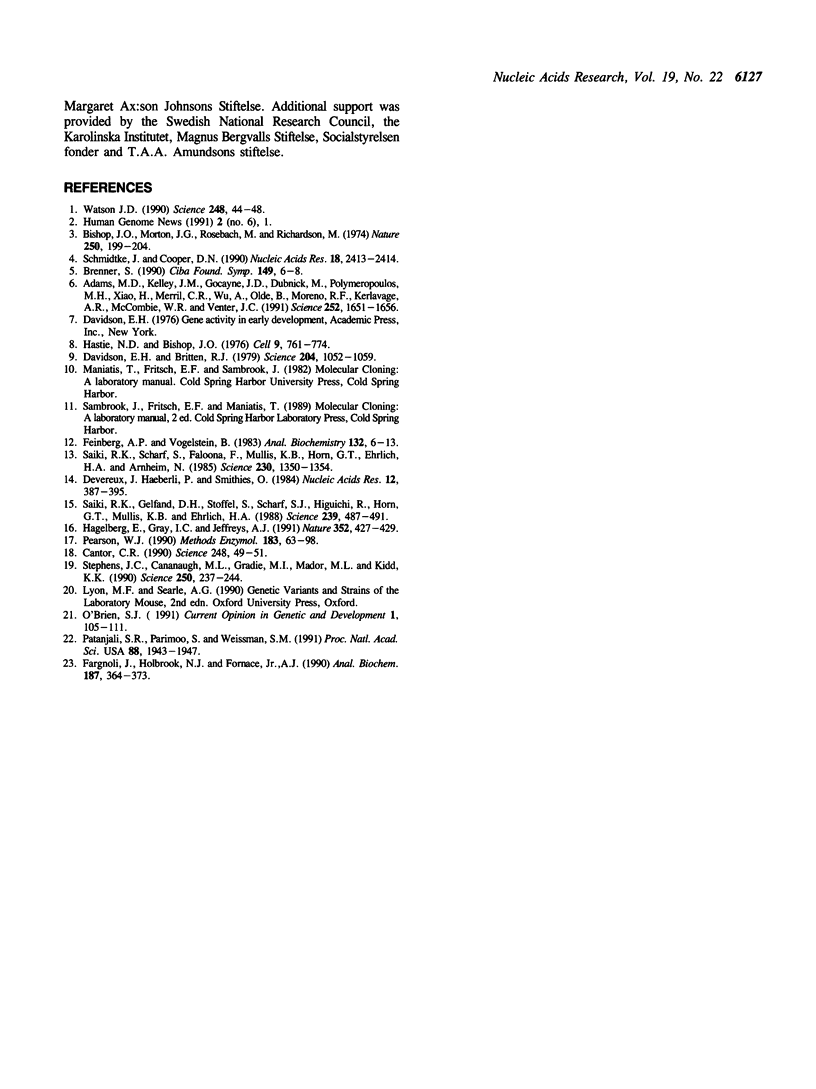Abstract
As part of the ongoing human and mouse genome projects, the aim of this study was to isolate novel, previously uncharacterized, genes from mouse testis. Two approaches were compared for their effectiveness in isolating novel genes: random, vs differential, complementary DNA (cDNA) cloning methods. In the differential approach, only the cDNA clones containing rare sequences (as determined by preliminary clone hybridization) are further analyzed; in the random approach, cDNA clones are isolated at random from the cDNA library. More than two hundred cDNA clones altogether were analyzed, using a PCR-mediated amplification and sequencing strategy. A comparison of these sequences to nucleic acid and protein sequence databases, revealed that 84% of the isolated rare cDNA clones represented new, previously uncharacterized mouse genes. In contrast, less than 63% of the cDNA clones isolated at random from cDNA libraries, contained novel genes. Thus, the probability of isolating new, previously uncharacterized, mammalian genes from cDNA libraries can be markedly improved by focusing efforts on clones containing rare sequences.
Full text
PDF




Selected References
These references are in PubMed. This may not be the complete list of references from this article.
- Adams M. D., Kelley J. M., Gocayne J. D., Dubnick M., Polymeropoulos M. H., Xiao H., Merril C. R., Wu A., Olde B., Moreno R. F. Complementary DNA sequencing: expressed sequence tags and human genome project. Science. 1991 Jun 21;252(5013):1651–1656. doi: 10.1126/science.2047873. [DOI] [PubMed] [Google Scholar]
- Bishop J. O., Morton J. G., Rosbash M., Richardson M. Three abundance classes in HeLa cell messenger RNA. Nature. 1974 Jul 19;250(463):199–204. doi: 10.1038/250199a0. [DOI] [PubMed] [Google Scholar]
- Brenner S. The human genome: the nature of the enterprise. Ciba Found Symp. 1990;149:6–17. doi: 10.1002/9780470513903.ch2. [DOI] [PubMed] [Google Scholar]
- Cantor C. R. Orchestrating the Human Genome Project. Science. 1990 Apr 6;248(4951):49–51. doi: 10.1126/science.2181666. [DOI] [PubMed] [Google Scholar]
- Davidson E. H., Britten R. J. Regulation of gene expression: possible role of repetitive sequences. Science. 1979 Jun 8;204(4397):1052–1059. doi: 10.1126/science.451548. [DOI] [PubMed] [Google Scholar]
- Devereux J., Haeberli P., Smithies O. A comprehensive set of sequence analysis programs for the VAX. Nucleic Acids Res. 1984 Jan 11;12(1 Pt 1):387–395. doi: 10.1093/nar/12.1part1.387. [DOI] [PMC free article] [PubMed] [Google Scholar]
- Fargnoli J., Holbrook N. J., Fornace A. J., Jr Low-ratio hybridization subtraction. Anal Biochem. 1990 Jun;187(2):364–373. doi: 10.1016/0003-2697(90)90471-k. [DOI] [PubMed] [Google Scholar]
- Feinberg A. P., Vogelstein B. A technique for radiolabeling DNA restriction endonuclease fragments to high specific activity. Anal Biochem. 1983 Jul 1;132(1):6–13. doi: 10.1016/0003-2697(83)90418-9. [DOI] [PubMed] [Google Scholar]
- Hagelberg E., Gray I. C., Jeffreys A. J. Identification of the skeletal remains of a murder victim by DNA analysis. Nature. 1991 Aug 1;352(6334):427–429. doi: 10.1038/352427a0. [DOI] [PubMed] [Google Scholar]
- Hastie N. D., Bishop J. O. The expression of three abundance classes of messenger RNA in mouse tissues. Cell. 1976 Dec;9(4 Pt 2):761–774. doi: 10.1016/0092-8674(76)90139-2. [DOI] [PubMed] [Google Scholar]
- O'Brien S. J. Mammalian genome mapping: lessons and prospects. Curr Opin Genet Dev. 1991 Jun;1(1):105–111. doi: 10.1016/0959-437x(91)80050-v. [DOI] [PubMed] [Google Scholar]
- Patanjali S. R., Parimoo S., Weissman S. M. Construction of a uniform-abundance (normalized) cDNA library. Proc Natl Acad Sci U S A. 1991 Mar 1;88(5):1943–1947. doi: 10.1073/pnas.88.5.1943. [DOI] [PMC free article] [PubMed] [Google Scholar]
- Pearson W. R. Rapid and sensitive sequence comparison with FASTP and FASTA. Methods Enzymol. 1990;183:63–98. doi: 10.1016/0076-6879(90)83007-v. [DOI] [PubMed] [Google Scholar]
- Saiki R. K., Gelfand D. H., Stoffel S., Scharf S. J., Higuchi R., Horn G. T., Mullis K. B., Erlich H. A. Primer-directed enzymatic amplification of DNA with a thermostable DNA polymerase. Science. 1988 Jan 29;239(4839):487–491. doi: 10.1126/science.2448875. [DOI] [PubMed] [Google Scholar]
- Saiki R. K., Scharf S., Faloona F., Mullis K. B., Horn G. T., Erlich H. A., Arnheim N. Enzymatic amplification of beta-globin genomic sequences and restriction site analysis for diagnosis of sickle cell anemia. Science. 1985 Dec 20;230(4732):1350–1354. doi: 10.1126/science.2999980. [DOI] [PubMed] [Google Scholar]
- Schmidtke J., Cooper D. N. A comprehensive list of cloned human DNA sequences. Nucleic Acids Res. 1990 Apr 25;18 (Suppl):2413–2547. doi: 10.1093/nar/18.suppl.2413. [DOI] [PMC free article] [PubMed] [Google Scholar]
- Stephens J. C., Cavanaugh M. L., Gradie M. I., Mador M. L., Kidd K. K. Mapping the human genome: current status. Science. 1990 Oct 12;250(4978):237–244. doi: 10.1126/science.2218527. [DOI] [PubMed] [Google Scholar]
- Watson J. D. The human genome project: past, present, and future. Science. 1990 Apr 6;248(4951):44–49. doi: 10.1126/science.2181665. [DOI] [PubMed] [Google Scholar]


